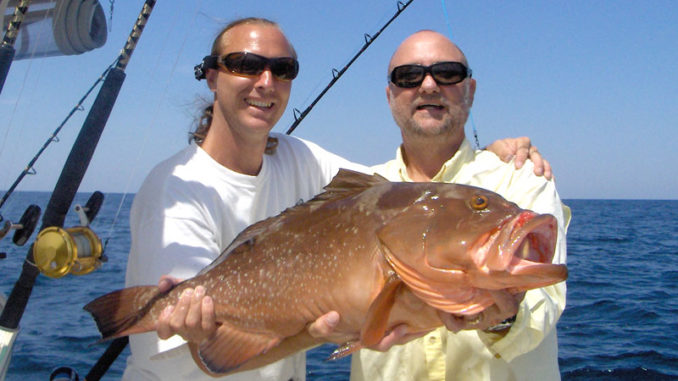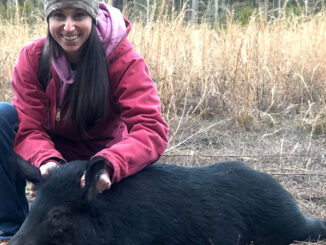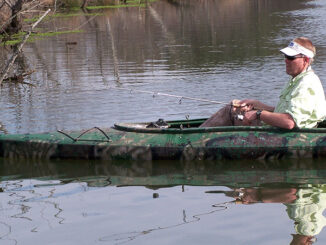
Be ready for anything and everything this month
For many, the end of the king mackerel bite on Carolina beaches, which neatly coincides with the end of king mackerel tournament season, it’s time to get the center console winterized and put away until spring.
Those who follow that game plan are often leaving themselves short. Some of the best fishing of the year can be had when early frost is on the ground. You just have to do things a bit differently.
The sustained cooling of the water on the beach generally pushes the bait and the predators that follow it offshore. This means a longer run to productive fishing.
To get the most satisfaction (not to mention meat in the box) on these late fall days, it pays to be ready to target different species on your trip. Be prepared with a set of live bait rods, enough stout bottom fishing rods to put one in every angler’s hand on the boat, and at least three 50-pound class trolling rods, spooled with plenty of braid and 80 to 100-pound topshots of mono. This allows you to take advantage of every opportunity you may encounter in the deep.
The first priority of one of these November trips is generally grouper, so loading up on live bait is a must. Instead of looking for a school of pogies to net, which can be hard to come by now, the best play is usually to stop at a nearshore AR and load up on cigar minnows.
As soon as you mark those “clouds” on the depth finder, send down two sabiki rigs and come tight on them as soon as they hit the bottom. If you’re not bringing up multiple cigars at one time, reposition the boat over a denser “cloud.” As long as you have found the right bait, it won’t take long at all until you have five or six dozen in the livewell.
At that point, see if you can grab a few pinfish as well. Add tiny pieces of cut squid on the bottom hooks of the sabiki. If the pinfish are there at all, this will be almost automatic. With a dozen or so pinfish along with the cigar minnows, you should be set for the day. Point the bow offshore and head for your favorite grouper hole in the depth range of 100 to 120 feet.
Watch the color
As you get offshore, pay close attention to the color of the water you are running through. In the depths that will be most productive, you can encounter clear, blue water or you may be in kingfish green water. A combination of the two with blended water or a hard edge isn’t uncommon, either.
If you hit the warmer, blue water with several miles yet to go, it’s a great time to slow down and troll high speed wahoo plugs on your 50-pound outfits all the way to your grouper hole. Three rods are all you can reasonably pull doing this, keeping whatever heavy plugs you prefer spaced out and the lines rubber banded to the reel handles or the first guide to create a quick, violent dropback/hookset coupled with an inexpensive strike alarm.
Some of the biggest ‘hoos of the year come from doing exactly this. If this technique doesn’t produce at first, keep the gear ready. Whenever you need to make a move, roll it back out again. It only takes a bite or two for high-speed trolling to dramatically increase the poundage you bring back to the dock.
Get a grouper
When you get to the ledge or rock where you want to target grouper, getting the boat positioned and stopped right on top of the numbers is critical. And it’s also going to take some time.
Whether you go with the tried-and-true anchor approach, or opt for the newer offshore trolling motor technique, the captain’s hands are full trying to get the boat in the right spot. While this is going on, have someone fire out one of the largest cigar minnows on a live bait “stinger” rig.
Filling a balloon a quarter full with water and the rest with air, then clipping it to the main line about 12 feet above the wire leader, allows the current to carry the bait well astern of where it can tangle any effort you are making to anchor.
As you get more set up, you can introduce a second or even a third live bait the same way. Just keep them staggered well apart. Simply keep light drag on these reels with the clickers engaged, put the rods in the T-top, and forget about them. You’ll know when you get bit. A king, wahoo, or even a sailfish may come calling while you are focusing on catching a grouper.
Dropping baits to the bottom for grouper means stout rods, heavy lines, big circle hooks, and tight drag. Hook a cigar minnow close to the tail and go straight down. Then engage the drag, getting the line tight.
When one of those rods doubles over, getting the grouper out of the rocks must happen immediately, or you will chafe or break even 130-pound mono leaders.
Switch it up
When the boat is positioned right, especially with the current restrictions on the different species of grouper, a limit can come quickly. You don’t necessarily have to move when everyone catches their allotment, though. Vermilion snapper are often in the same spot, so sending down some cut squid on smaller tackle can give the fish box a bit of a boost too. Or you can troll a bit farther offshore and try to augment that same box with a different flavor of grouper.
Typically, the gags will be the shallowest species found. Going deeper opens the door for reds, scamps, and a whole host of other types of some of the most delicious fish on the planet. Rock hopping combined with high-speed trolling is a fantastic way to catch a smorgasbord of seafood.
While you are maximizing your catch and your day on the water, don’t forget that November (especially the latter part of the month) is a great time to see early season bluefin showing up on the Carolina coast.
The same 50-pound outfits make catching one of these giants possible, so long as you have plenty of line to handle the runs of these fish.
A quick switch to 100-pound, fluorocarbon “crank-on” leaders with Ilander heads and horse ballyhoo on 11/0 hooks will immediately put doing battle with a true giant in play. When you see bluefins busting on bait, you will immediately know what they are. Just make sure you have plenty of daylight left to play that game, so you don’t have to run back through a tricky inlet in the dark.
Always make sure your permits are in order as well, in case you want to take one of these giants home. I’m not advocating keeping one, but if you do, you want to be sure that you are on the legal side of things when you get back to the dock.
It may not be summer fishing, but if you come prepared for what you may encounter offshore, there’s no reason the action in November won’t be just as hot and heavy.
Stay legal:
Bluefin tuna can make a strong showing toward the end of this month. Anglers targeting other species can take advantage of these big fish, but harvesting them requires the proper permits. Make sure you have the right paperwork and you’ll be ready if and when these tasty tuna decide to bite.




Be the first to comment